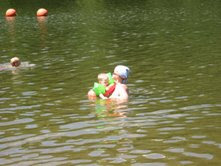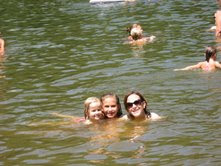
From World’s Healthiest Foods
What vegetable is more synonymous with the coming of summer than freshly picked corn on the cob? Although corn is now available in markets year-round, it is the locally grown varieties that you can purchase during the summer months that not only tastes the best but are usually the least expensive.
Corn grows in “ears,” each of which is covered in rows of kernels that are then protected by the silk-like threads called “corn silk” and encased in a husk. Corn is known scientifically as Zea mays. This moniker reflects its traditional name, maize, by which it was known to the Native Americans as well as many other cultures throughout the world.
Health Benefits
Hot, fresh corn-on-the-cob is an almost essential part of any summertime party. Fortunately, it is also worthy part of any healthful menu. Our food ranking system qualified corn as a good source of many nutrients including thiamin (vitamin B1), pantothenic acid (vitamin B5), folate, dietary fiber, vitamin C, phosphorus and manganese.
Corn for Cardiovascular Health
Corn’s contribution to heart health lies not just in its fiber, but in the significant amounts of folate that corn supplies.
Folate, which you may know about as a B-vitamin needed to prevent birth defects, also helps to lower levels of homocysteine, an amino acid that is an intermediate product in an important metabolic process called the methylation cycle. Homocysteine can directly damage blood vessels, so elevated blood levels of this dangerous molecule are an independent risk factor for heart attack, stroke, or peripheral vascular disease, and are found in between 20-40% of patients with heart disease. It has been estimated that consumption of 100% of the daily value (DV) of folate would, by itself, reduce the number of heart attacks suffered by Americans each year by 10%. Folate-rich diets are also associated with a reduced risk of colon cancer. A cup of corn supplies 19.0% of the DV for folate
Supports Lung Health
Consuming foods rich in beta-cryptoxanthin, an orange-red carotenoid found in highest amounts in corn, pumpkin, papaya, red bell peppers, tangerines, oranges and peaches, may significantly lower one’s risk of developing lung cancer. A study published in Cancer Epidemiology, Biomarkers and Prevention reviewed dietary and lifestyle data collected from over 63,000 adults in Shanghai, China, who were followed for 8 years. Those eating the most crytpoxanthin-rich foods showed a 27% reduction in lung cancer risk. When current smokers were evaluated, those who were also in the group consuming the most cryptoxanthin-rich foods were found to have a 37% lower risk of lung cancer compared to smokers who ate the least of these health-protective foods.
Maintain Your Memory with Thiamin (Vitamin B1)
Corn is a good source of thiamin, providing about one-quarter (24.0%) of the daily value for this nutrient in a single cup. Thiamin is an integral participant in enzymatic reactions central to energy production and is also critical for brain cell/cognitive function. This is because thiamin is needed for the synthesis of acetylcholine, a neurotransmitter essential for memory, whose lack has been found to be a significant contributing factor in age-related impairment in mental function (senility) and Alzheimer’s disease. In fact, Alzheimer’s disease is clinically characterized by a decrease in acetylcholine levels. Don’t forget to make corn a staple in your healthy diet.
Support for Energy Production, Even Under Stress
In addition to its thiamin, corn is a good source of pantothenic acid. This B vitamin is necessary for carbohydrate, protein and lipid metabolism. Pantothenic acid is an especially valuable B-vitamin when you’re under stress since it supports the function of the adrenal glands. A cup of corn supplies 14.4% of the daily value for pantothenic acid.
Health-Promoting Activity Equal to or Even Higher than that of Vegetables and Fruits
Research reported at the American Institute for Cancer Research (AICR) International Conference on Food, Nutrition and Cancer, by Rui Hai Liu, M.D., Ph.D., and his colleagues at Cornell University shows that whole grains, such as corn, contain many powerful phytonutrients whose activity has gone unrecognized because research methods have overlooked them.
Despite the fact that for years researchers have been measuring the antioxidant power of a wide array of phytonutrients, they have typically measured only the “free” forms of these substances, which dissolve quickly and are immediately absorbed into the bloodstream. They have not looked at the “bound” forms, which are attached to the walls of plant cells and must be released by intestinal bacteria during digestion before they can be absorbed.
Phenolics, powerful antioxidants that work in multiple ways to prevent disease, are one major class of phytonutrients that have been widely studied. Included in this broad category are such compounds as quercetin, curcumin, ellagic acid, catechins, and many others that appear frequently in the health news.
When Dr. Liu and his colleagues measured the relative amounts of phenolics, and whether they were present in bound or free form, in common fruits and vegetables like apples, red grapes, broccoli and spinach, they found that phenolics in the “free” form averaged 76% of the total number of phenolics in these foods. In whole grains, however, “free” phenolics accounted for less than 1% of the total, while the remaining 99% were in “bound” form.
In his presentation, Dr. Liu explained that because researchers have examined whole grains with the same process used to measure antioxidants in vegetables and fruits-looking for their content of “free” phenolics”-the amount and activity of antioxidants in whole grains has been vastly underestimated.
Despite the differences in fruits’, vegetables’ and whole grains’ content of “free” and “bound” phenolics, the total antioxidant activity in all three types of whole foods is similar, according to Dr. Liu’s research. His team measured the antioxidant activity of various foods, assigning each a rating based on a formula (micromoles of vitamin C equivalent per gram). Broccoli and spinach measured 80 and 81, respectively; apple and banana measured 98 and 65; and of the whole grains tested, corn measured 181, whole wheat 77, oats 75, and brown rice 56.
Dr. Liu’s findings may help explain why studies have shown that populations eating diets high in fiber-rich whole grains consistently have lower risk for colon cancer, yet short-term clinical trials that have focused on fiber alone in lowering colon cancer risk, often to the point of giving subjects isolated fiber supplements, yield inconsistent results. The explanation is most likely that these studies have not taken into account the interactive effects of all the nutrients in whole grains-not just their fiber, but also their many phytonutrients. As far as whole grains are concerned, Dr. Liu believes that the key to their powerful cancer-fighting potential is precisely their wholeness. A grain of whole wheat consists of three parts-its endosperm (starch), bran and germ. When wheat-or any whole grain-is refined, its bran and germ are removed. Although these two parts make up only 15-17% of the grain’s weight, they contain 83% of its phenolics. Dr. Liu says his recent findings on the antioxidant content of whole grains reinforce the message that a variety of foods should be eaten good health. “Different plant foods have different phytochemicals,” he said. “These substances go to different organs, tissues and cells, where they perform different functions. What your body needs to ward off disease is this synergistic effect – this teamwork – that is produced by eating a wide variety of plant foods, including whole grains.”















